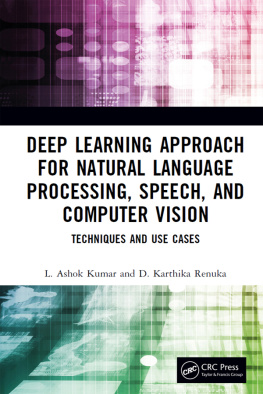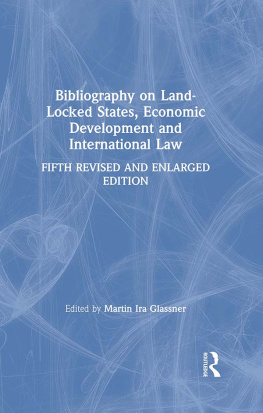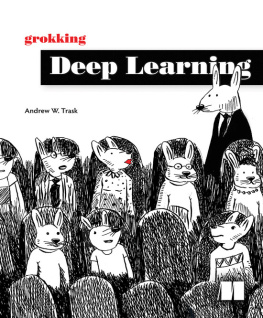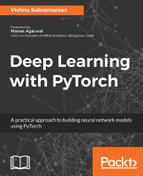Andrew Glassner - Deep Learning: A Visual Approach
Here you can read online Andrew Glassner - Deep Learning: A Visual Approach full text of the book (entire story) in english for free. Download pdf and epub, get meaning, cover and reviews about this ebook. year: 2021, publisher: No Starch Press, genre: Home and family. Description of the work, (preface) as well as reviews are available. Best literature library LitArk.com created for fans of good reading and offers a wide selection of genres:
Romance novel
Science fiction
Adventure
Detective
Science
History
Home and family
Prose
Art
Politics
Computer
Non-fiction
Religion
Business
Children
Humor
Choose a favorite category and find really read worthwhile books. Enjoy immersion in the world of imagination, feel the emotions of the characters or learn something new for yourself, make an fascinating discovery.

- Book:Deep Learning: A Visual Approach
- Author:
- Publisher:No Starch Press
- Genre:
- Year:2021
- Rating:5 / 5
- Favourites:Add to favourites
- Your mark:
- 100
- 1
- 2
- 3
- 4
- 5
Deep Learning: A Visual Approach: summary, description and annotation
We offer to read an annotation, description, summary or preface (depends on what the author of the book "Deep Learning: A Visual Approach" wrote himself). If you haven't found the necessary information about the book — write in the comments, we will try to find it.
Deep Learning: A Visual Approach — read online for free the complete book (whole text) full work
Below is the text of the book, divided by pages. System saving the place of the last page read, allows you to conveniently read the book "Deep Learning: A Visual Approach" online for free, without having to search again every time where you left off. Put a bookmark, and you can go to the page where you finished reading at any time.
Font size:
Interval:
Bookmark:

Andrew Glassner

San Francisco
Deep Learning: A Visual Approach. Copyright 2021 by Andrew Glassner.
All rights reserved. No part of this work may be reproduced or transmitted in any form or by any means, electronic or mechanical, including photocopying, recording, or by any information storage or retrieval system, without the prior written permission of the copyright owner and the publisher.
ISBN-13: 978-1-7185-0072-3 (print)
ISBN-13: 978-1-7185-0073-0 (ebook)
Publisher: William Pollock
Executive Editor: Barbara Yien
Production Editors: Maureen Forys and Rachel Monaghan
Developmental Editor: Alex Freed
Cover and Interior Design: Octopod Studios
Cover Illustrator: Gina Redman
Technical Reviewers: George Hosu and Ron Kneusel
Copyeditor: Rebecca Rider
Compositor: Maureen Forys, Happenstance Type-O-Rama
Proofreader: James Fraleigh
With the exception of the images noted at the end of the book in the Image Credits, all the images in this book are produced by the author. All original images may be freely downloaded from https://github.com/blueberrymusic and used as the reader pleases.
For information on book distributors or translations, please contact No Starch Press, Inc. directly:
No Starch Press, Inc.
245 8th Street, San Francisco, CA 94103
phone: 1-415-863-9900; info@nostarch.com
www.nostarch.com
Library of Congress Cataloging-in-Publication Data
Names: Glassner, Andrew S., author.
Title: Deep learning : a visual approach / Andrew Glassner.
Description: San Francisco, CA : No Starch Press, Inc., [2021] | Includes
bibliographical references and index.
Identifiers: LCCN 2020047326 (print) | LCCN 2020047327 (ebook) | ISBN
9781718500723 (paperback) | ISBN 9781718500730 (ebook)
Subjects: LCSH: Machine learning. | Neural networks.
Classification: LCC Q325.5 .G58 2021 (print) | LCC Q325.5 (ebook) | DDC
006.3/1--dc23
LC record available at https://lccn.loc.gov/2020047326
LC ebook record available at https://lccn.loc.gov/2020047327
No Starch Press and the No Starch Press logo are registered trademarks of No Starch Press, Inc. Other product and company names mentioned herein may be the trademarks of their respective owners. Rather than use a trademark symbol with every occurrence of a trademarked name, we are using the names only in an editorial fashion and to the benefit of the trademark owner, with no intention of infringement of the trademark.
The information in this book is distributed on an As Is basis, without warranty. While every precaution has been taken in the preparation of this work, neither the author nor No Starch Press, Inc. shall have any liability to any person or entity with respect to any loss or damage caused or alleged to be caused directly or indirectly by the information contained in it.
For Niko,
whos always there
with a smile,
a paw,
and a wag.
Dr. Andrew Glassner is a Senior Research Scientist at Weta Digital, where he uses deep learning to help artists produce visual effects for film and television. He was Technical Papers Chair for SIGGRAPH 94, Founding Editor of the Journal of Computer Graphics Tools, and Editor-in-Chief of ACM Transactions on Graphics. His prior books include the Graphics Gems series and the textbook Principles of Digital Image Synthesis. Glassner holds a PhD from UNC-Chapel Hill. He paints, plays jazz piano, and writes novels. His website is www.glassner.com, and he can be followed on Twitter as @AndrewGlassner.
George Hosu is a software engineer and world traveler with a broad interest in statistics and machine learning. He works as the lead machine learning engineer on an autoML and explainable AI project called Mindsdb. In his spare time, he writes to strengthen his understanding of epistemology, ML, and classical mathematics, and how they all come together to generate a meaningful map of the world. You can find his writing at https://blog.cerebralab.com/.
Ron Kneusel has been working with machine learning in industry since 2003 and completed a PhD in machine learning from the University of Colorado, Boulder, in 2016. Ron currently works for L3Harris Technologies, Inc. He has two books available from Springer: Numbers and Computers, and Random Numbers and Computers.
Authors like to say that nobody writes a book alone. We say that because its true. It gives me great pleasure to thank my friends and colleagues who helped me make this book possible.
For their consistent and enthusiastic support of this project, and for helping me feel good about it all the way through, I am enormously grateful to Eric Braun, Steven Drucker, Eric Haines, and Morgan McGuire. Thanks also to Georgia, Jenn, and Michael Ambrose for always providing cheerful conversation after Id spent too long at the computer.
Thanks to the reviewers of this books first edition, whose generous and insightful comments greatly improved the presentation: Adam Finkelstein, Alex Colburn, Alyn Rockwood, Angelo Pesce, Barbara Mones, Brian Wyvill, Craig Kaplan, Doug Roble, Eric Braun, Greg Turk, Jeff Hultquist, Kristi Morton, Lesley Istead, Matt Pharr, Mike Tyka, Morgan McGuire, Paul Beardsley, Paul Strauss, Peter Shirley, Philipp Slusallek, Serban Porumbescu, Stefanus Du Toit, Steven Drucker, Wenhao Yu, and Zackory Erickson.
Special thanks to super reviewers Alexander Keller, Eric Haines, Jessica Hodgins, and Luis Alvarado, who read the whole first edition and offered wonderful feedback on both presentation and structure. Thank you to technical reviewers George Hosu and Ron Kneusel for their insights.
Thanks to Todd Szymanski for advice on the design and layout of the books first edition and to Morgan McGuire for the Markdeep layout system, which enabled me to focus on writing and not word processing mechanics.
Thank you to the wonderful folks at No Starch Press for taking on this large project. Giant thanks to my editor Alex Freed, who read through the entire manuscript and offered numerous insightful comments and suggestions that greatly improved it throughout. Thank you to copyeditor Rebecca Rider and production editor Maureen Forys. Thank you to Rachel Monaghan for shepherding this project to completion with skill and grace. Thanks to publisher Bill Pollock for believing in the book and supporting the process.
My terrific colleagues at Weta Digital, Ltd. gave me professional and personal support and encouragement as I tackled this second edition. Thank you to Antoine Bouthors, Jedrzej Wojtowicz, Joe Letteri, Luca Fascione, Millie Maier, Navi Brouwer, Tom Buys, and Yann Provencher.
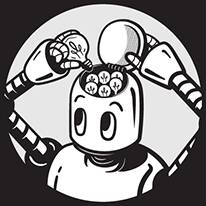
Imagine that youre rubbing a golden lamp. You say, Genie, for my three wishes, give me someone to love, great wealth, and a long and healthy life.
Now imagine that youre entering your home. You say, House, bring the car around, ask Sarah if shes free for lunch, schedule a haircut, and make me a latte. Oh, and play some Thelonious Monk, please.
In both of these situations, youre asking a disembodied being of great power to hear you, understand you, and fulfill your desires. The first scenario is a fantasy going back millennia. The second scenario is commonplace reality today, thanks to artificial intelligence, or AI.
Font size:
Interval:
Bookmark:
Similar books «Deep Learning: A Visual Approach»
Look at similar books to Deep Learning: A Visual Approach. We have selected literature similar in name and meaning in the hope of providing readers with more options to find new, interesting, not yet read works.
Discussion, reviews of the book Deep Learning: A Visual Approach and just readers' own opinions. Leave your comments, write what you think about the work, its meaning or the main characters. Specify what exactly you liked and what you didn't like, and why you think so.


